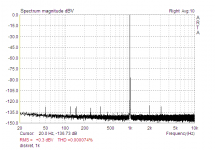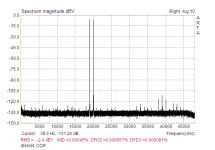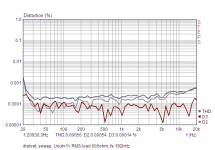Try to make Your own measurements with EVB for PGA, and after then make conclusions . I used PGA for short period, and I must leave it, because listeners complained "something is wrong", measurements confirm this.. I wrote my experiences to manufacturer with measurements results, no response. Really, something is strange... , But believe , or not, it is Yours decision.
I am not "begginer" , I can make preamp with results as posted in attachment
I am not "begginer" , I can make preamp with results as posted in attachment
Attachments
Last edited:
At least part of the story appears to be that people get used to a certain quality of distortion, and they expect it to be always present, as a mark of "normal" sound reproduction. So for them any system that doesn't display these characteristics is somehow not correct, even though it may actually sound more like the real thing than what they prefer. I have been surprised many times by what some people prefer, a somewhat artificial, hyped up presentation that has to be at exactly the right volume to sound "right", and which immediately sounds unpleasant if anything except the "correct" recordings are played. Each to their own, I guess ...
Frank
Frank
Last edited:
Oh, please, BV and PMA, don't justify, i'm not thinking anything negative about your expertise, on the contrary. And i believe your experience. That's why i was arguing, trying to understand why i prefer those CIs to pots on my system, and not you on yours.
May-be we are not searching for the same things, listening to the same kind of music, may-be our enclosures do not present the things the same ways, who knows ?
I use horns and fast amps (current feedback) , love jazz etc. What are your systems ?
About THD measurements, as long as they are not awful and reveal a failure, i do not care too much about them.
May-be we are not searching for the same things, listening to the same kind of music, may-be our enclosures do not present the things the same ways, who knows ?
I use horns and fast amps (current feedback) , love jazz etc. What are your systems ?
About THD measurements, as long as they are not awful and reveal a failure, i do not care too much about them.
fas42, any musical instruments produce its own harmonics. H2 & H3 are always present in the original signal.
Little HD does not change the sound more than if the mike was positioned a little aside. The risk is, if HD is too high, the texture of the instruments begins to change and the whole scene to be monotone (or awful). (h2 and H3, high order is more perverse)
It is the IM that i fear much, as it brings noises betwwen the instruments and blurs the signal, plus the lack of instant dynamic witch kill the life.
Little HD does not change the sound more than if the mike was positioned a little aside. The risk is, if HD is too high, the texture of the instruments begins to change and the whole scene to be monotone (or awful). (h2 and H3, high order is more perverse)
It is the IM that i fear much, as it brings noises betwwen the instruments and blurs the signal, plus the lack of instant dynamic witch kill the life.
Yes, there is a non-linear transfer function that is both frequency and amplitude dependent. Thd and ccif only help to visualize non-linearities. These non-linearities should be minimized as a necessary condition. And we have methods how to zoom and reveal the non-linearities.
According Levinson preamp, how do You know, they used PGA?
They didn't use PGA (nor have I tried it myself). They used MDAC, which you said (I quoted you twice) was easy to distinguish from relays by measurement and listening. Then you said it wasn't easy to distinguish from relays by measurement and listening. So... my congratulations were for correcting your initial incorrect statement. I don't know about PGA, but MDACs are a superb way of avoiding the well-known issues of mechanical analog volume controls.
It has nothing to do with "instinctively rejection..
If you inferred that I was talking about you, my apologies. I wasn't.
I vote for manual rotary stepped attenuator or relay resistor network. And blue Alps 10k is also sonically better than any PGA.
6moons audio reviews: Esoteric C-03
6moons audio reviews: Esoteric C-03
ESOTERIC Stereo Linestage Preamplifier C-03 | ESOTERIC COMPANY
Still winning accolades 4 years after they first started using the PGA23xx
Leave you preconceptions out of this. When well implemented, it's an awesome chip.
You don't care about a lot of things, PMA, including measurements - selectively, of course.
Still waiting an answer regarding the NCore measurements, for instance.
In other news, I'd be happy if my favorite music tracks were recorder using something like this.
I'll be even happier the day I get it for my own system. Yeah, PGA2311s and 5532s inside. Sad really (that competitors with better "ingredients" can't do much better).
Some measurements here (using google translate).
Still waiting an answer regarding the NCore measurements, for instance.
In other news, I'd be happy if my favorite music tracks were recorder using something like this.
I'll be even happier the day I get it for my own system. Yeah, PGA2311s and 5532s inside. Sad really (that competitors with better "ingredients" can't do much better).
Some measurements here (using google translate).
I don't care about magazine reviews. Not enough info to get complete view.
Then read the specifications and do an audition
Thanks PMA and BV for sticking to the subject and TEACHING ME something useful.
PMA, your selection of favored attenuators follows mine, although we have never met each other. My preferences were put up earlier.
The Alps pots, which I have used, for the last 30 years, of virtually all types and values, appears to be a pretty good, versatile and economical solution, BUT that does not mean that they are NOT AUDIBLE over long listening times. I have an ALPS (super quality model) in the input of my STAX Lambda Tube drive headphone amp, and I found that the headphones sounded better if I just turned it up all the way, and ADDED a better pot in series. What a hassle, but there it is. Decades ago, another young recording engineer who generally recorded concerts in the Berkeley area had the same experience with the input pot. We compared notes later, and found much the same thing.
Now, could I personally measure anything? No, not to levels to -100dB (.001%) at any setting, and of course we TRIED to measure something interesting.
Now, please remember, PMA is right. The reviewers can't measure each preamp at EVERY LEVEL, so they usually put the control at 0dB (no gain, no loss) in the attenuator, so they can reasonably COMPARE different preamps.
Back in 1974, when the first JC-2 came into my possession, I measured it the same way, with the pots on full, or 0dB loss. It measured great!
In subsequent listening tests where the JC-2 was added as a preamp, we had a problem, and don't think that I was not embarrassed! Both John Meyer (a colleague at the time) and another listener (his father owed the best hi end audio shop in Berkeley at the time) insisted that the JC-2 preamp was adding distortion to the system, because THEY COULD HEAR IT. I, at first, didn't believe it. My baby distort?
Well, at one point I just said, let's test the JC-2 (we had a Crown IMA and a B&K wave analyzer in our lab). DON'T TOUCH THE SETTINGS. And I hand carried it to the test bench and found LOTS of higher order distortion. Yet, when I moved the pot, one way or another, the distortion dropped to the residual of the equipment.
It was the pot that had bad spots, that distorted at certain settings.
Later, in the USA, I showed Mark Levinson the problem with his own lab equipment. Rubbed his nose in it, so to speak. So, what came next was a succession of replacement pots, first wirewound, that seemed OK at first, but apparently went bad over time, and finally Mark Levinson himself convinced P&G to make a custom dual rotary pot for audio, and that remained the standard for years. Before this, P&G only made military grade rotary pots. I still have a sample that I got in 1975 from them. Beautifully made, but the wrong configuration for audio.
Now where does it leave us? NEVER TRUST a single measurement of an attenuator, which MAY have varying distortion with level, either electronic or passive.
And, unfortunately, while there are pots and attenuators that sound 'better' than the Alps, the Alps is usually better than virtually any electronic attenuator.
Finding that electronic attenuator that really does the job right is what we are after, because Alps is not making much, anymore.
PMA, your selection of favored attenuators follows mine, although we have never met each other. My preferences were put up earlier.
The Alps pots, which I have used, for the last 30 years, of virtually all types and values, appears to be a pretty good, versatile and economical solution, BUT that does not mean that they are NOT AUDIBLE over long listening times. I have an ALPS (super quality model) in the input of my STAX Lambda Tube drive headphone amp, and I found that the headphones sounded better if I just turned it up all the way, and ADDED a better pot in series. What a hassle, but there it is. Decades ago, another young recording engineer who generally recorded concerts in the Berkeley area had the same experience with the input pot. We compared notes later, and found much the same thing.
Now, could I personally measure anything? No, not to levels to -100dB (.001%) at any setting, and of course we TRIED to measure something interesting.
Now, please remember, PMA is right. The reviewers can't measure each preamp at EVERY LEVEL, so they usually put the control at 0dB (no gain, no loss) in the attenuator, so they can reasonably COMPARE different preamps.
Back in 1974, when the first JC-2 came into my possession, I measured it the same way, with the pots on full, or 0dB loss. It measured great!
In subsequent listening tests where the JC-2 was added as a preamp, we had a problem, and don't think that I was not embarrassed! Both John Meyer (a colleague at the time) and another listener (his father owed the best hi end audio shop in Berkeley at the time) insisted that the JC-2 preamp was adding distortion to the system, because THEY COULD HEAR IT. I, at first, didn't believe it. My baby distort?
Well, at one point I just said, let's test the JC-2 (we had a Crown IMA and a B&K wave analyzer in our lab). DON'T TOUCH THE SETTINGS. And I hand carried it to the test bench and found LOTS of higher order distortion. Yet, when I moved the pot, one way or another, the distortion dropped to the residual of the equipment.
It was the pot that had bad spots, that distorted at certain settings.
Later, in the USA, I showed Mark Levinson the problem with his own lab equipment. Rubbed his nose in it, so to speak. So, what came next was a succession of replacement pots, first wirewound, that seemed OK at first, but apparently went bad over time, and finally Mark Levinson himself convinced P&G to make a custom dual rotary pot for audio, and that remained the standard for years. Before this, P&G only made military grade rotary pots. I still have a sample that I got in 1975 from them. Beautifully made, but the wrong configuration for audio.
Now where does it leave us? NEVER TRUST a single measurement of an attenuator, which MAY have varying distortion with level, either electronic or passive.
And, unfortunately, while there are pots and attenuators that sound 'better' than the Alps, the Alps is usually better than virtually any electronic attenuator.
Finding that electronic attenuator that really does the job right is what we are after, because Alps is not making much, anymore.
6moons audio reviews: Esoteric C-03
6moons audio reviews: Esoteric C-03
ESOTERIC Stereo Linestage Preamplifier C-03 | ESOTERIC COMPANY
Still winning accolades 4 years after they first started using the PGA23xx
Leave you preconceptions out of this. When well implemented, it's an awesome chip.
The w4s STP-SE uses relay ladder volume control... test also compare/reference to the C-03.
6moons audio reviews: Wyred4Sound STP
/
Try to make Your own measurements with EVB for PGA, and after then make conclusions . I used PGA for short period, and I must leave it, because listeners complained "something is wrong", measurements confirm this.. I wrote my experiences to manufacturer with measurements results, no response. Really, something is strange... , But believe , or not, it is Yours decision.
I am not "begginer" , I can make preamp with results as posted in attachment
Which ADC/DAC are you using for these measurements? The residuals are lower than any I have seen.
I have also used relays, first choice for consistancy and lo distortion and motor driven servo pot (Nuforce P9). The slow response of the pot brought on some pushback from customers so the new products use a variation on the MAS6116 concept but without the gain option. The pot (an Alps motor driven pot) has lower distortion.
Yes (my bold in the first excerpt above). And pots will always deteriorate after a while.It was the pot that had bad spots, that distorted at certain settings.
NEVER TRUST a single measurement of an attenuator, which MAY have varying distortion with level, either electronic or passive.
And, unfortunately, while there are pots and attenuators that sound 'better' than the Alps, the Alps is usually better than virtually any electronic attenuator.
Electronic attenuators will do so, if at all, much more slowly, but will also have variations with setting. And they will always have large signal overload effects, and usually more thermal noise.
Now the best of them do a good job, and especially in terms of consistency and longevity. To do better is a whole lot of work.
And pots will always deteriorate after a while.
.
Alps is pretty good with its multi-point wiper contact. Do not push a DC current through.
Yes, John, pots are EVIL

Why don't you just listen to music, even with some distortion ? :
Average White Band - Pick up the pieces - YouTube
Oh ? Pots on the guitars too ? It's a conspiracy.

Why don't you just listen to music, even with some distortion ? :
Average White Band - Pick up the pieces - YouTube
Oh ? Pots on the guitars too ? It's a conspiracy.
Last edited:
Yes, and take their power dissipation ratings seriouslyAlps is pretty good with its multi-point wiper contact. Do not push a DC current through.
- Status
- Not open for further replies.
- Home
- Member Areas
- The Lounge
- John Curl's Blowtorch preamplifier part II


